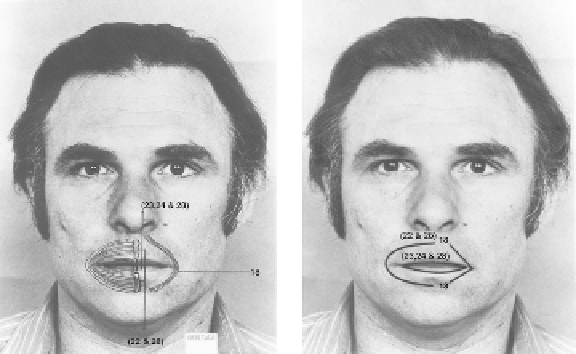Graphics Reference
In-Depth Information
10.1.2
The facial action coding system
The facial action coding system (FACS) is the result of research conducted by the psychologists Ekman
and Friesen [
13
] with the objective of deconstructing all facial expressions into a set of basic facial
movements. These movements, called action units, or AUs, when considered in combinations, can
be used to describe all facial expressions.
Forty-six AUs are identified in the study, and they provide a clinical basis from which to build a
facial animation system. Examples of AUs are brow lowerer, inner brow raiser, wink, cheek raiser,
upper lip raiser, and jaw drop. See
Figure 10.3
for an example of diagrammed AUs. Given the
AUs, an animator can build a facial model that is parameterized according to the motions of the
AUs. A facial animation system can be built by giving a user access to a set of variables that are in
one-to-one correspondence with the AUs. A parametric value controls the amount of the facial motion
that results from the associated AU. By setting a variable for each AU, the user can generate all of the
facial expressions analyzed by Ekman and Friesen. By using the value of the variables to interpolate the
degree to which the motion is realized and by interpolating their value over time, the user can then
animate the facial model. By combining the AUs in nonstandard ways, the user can also generate many
truly strange expressions.
While this work is impressive and is certainly relevant to facial animation, two of its characteristics
should be noted before it is used as a basis for a facial animation system. First, the FACS is meant to be
descriptive of a static expression, not generative. Second, the FACS is not time based, and facial move-
ments are analyzed only relative to a neutral pose. This means that the AUs were not designed to ani-
mate a facial model in all the ways that an animator may want to control a face. In addition, the FACS
describes facial expressions, not speech. The movements for forming individual phonemes, the basic
units of speech, were not specifically incorporated into the system. While the AUs provide a good start-
ing point for describing the basic motions that must be in a facial animation system, they were never
intended for this purpose.
FIGURE 10.3
Three AUs of the lower face [
13
].




Search WWH ::

Custom Search